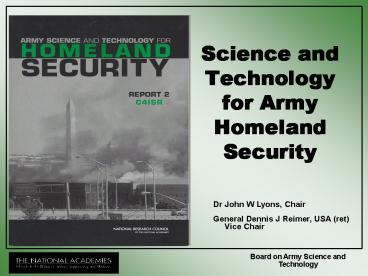Science and Technology for Army Homeland Security - PowerPoint PPT Presentation
1 / 9
Title:
Science and Technology for Army Homeland Security
Description:
... many similarities between military operations involving allied or ... Work with the DHS to find common areas of science and technology collaboration; and ... – PowerPoint PPT presentation
Number of Views:49
Avg rating:3.0/5.0
Title: Science and Technology for Army Homeland Security
1
Science and Technology for Army Homeland
Security
Dr John W Lyons, Chair General Dennis J Reimer,
USA (ret) Vice Chair
2
NRC-BAST Studies
- Science and Technology for Army Homeland Security
Report 1 - 2003 - Survey of Army Technologies
- Army Science and Technology for Homeland Security
Report 2 - 2004 - C4ISR Technologies
3
Report 1
- Army still responsible for DOD efforts on
Homeland Security/support. - Statement of Task areas of emphasis
- Indications and Warnings
- Denial and Survivability
- Recovery and Consequence Management
- Attribution and Retaliation
4
Study Methodology
Technology Review
- Working groups identified functional capabilities
/ technology areas required - Specific products were not addressed
- Determined technology maturity
5
Examples of Army Technologies
- Infrared Imaging sensors
- Bioagent and explosives detection
- Blast resistance for buildings
- Command and control
- Blue Force Tracking
- C2 on the Move
- Situational Awareness
- Medical CBR Triage
- Decontamination
- Multi-sensor fusion
- Robotics
6
Report 1 - Findings
- Homeland security is an important extension of
the Armys historical role of providing support
to civilian authorities. - The Army National Guard is the key Army asset to
meet homeland security demands. - There are many similarities between military
operations involving allied or coalition forces
and operations involving civilian emergency
responders.
7
Report 2 - Statement of Task
- In this follow-on study, focusing on the C4ISR
area and the first responder mission, the
National Research Council will - Examine stated capabilities needed for Homeland
Security and the Armys Future Force, identifying
areas of similar technical needs. - Highlight Army technology and systems solutions
under development (in both ST and Acquisition)
for the Future Force which can meet the needs of
the Department of Homeland Security.
8
Example Technologies of Mutual Interest
- Joint interoperable communication
- Shared operational pictures
- Tactical networking
- Mobile networking
- Smart sensor webs
- Advanced IR sensors
- Command and control in complex and urban
settings - Decision support systems
- Physiological monitoring of individuals
9
Report 2 - Recommendations
- Put in place and institutionalize a process for
collaboration and sharing between the Army and
the DHS - Assist the DHS in establishing the research,
development, testing, and evaluation
infrastructure to support the emergency responder
community - Work with the DHS to find common areas of science
and technology collaboration and - Work with the DHS to establish processes for
joint civil-military operations, including joint
training and exercises, shared standards, and
interoperable systems.































